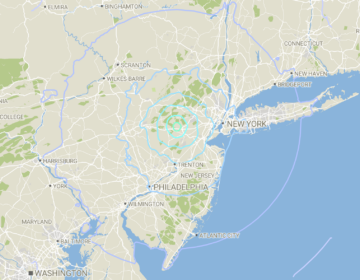Global heat waves show climate change and El Niño are a bad combo

Outdoor workers are vulnerable to prolonged heat waves like the one hitting Texas, which climate scientist warn are becoming more common. (David J. Phillip/AP)
If there’s one kind of weather extreme that scientists clearly link to climate change, it’s worsening heat waves.
“They are getting hotter,” says Kai Kornhuber, adjunct scientist at Columbia University and scientist at Climate Analytics, a climate think tank. “They are occurring at a higher frequency, so that also increases the likelihood of sequential heat waves.”
In Texas, the Southern U.S. and Mexico, a three-week heat wave has gripped the region with temperature records falling for days in a row. Extreme heat has also hit India, China and Canada, where widespread wildfires are burning.
“Most of the world’s population has experienced record-breaking heat in recent days,” says Daniel Swain, climate scientist at the University of California-Los Angeles.
This year, something else is adding fuel to the fire: the El Niño climate pattern. That seasonal shift makes global temperatures warmer, which could make 2023 the hottest year ever recorded.
Longer heat waves are more dangerous
Heat waves are already the deadliest weather-related disaster in the U.S.. Not only do extreme temperatures cause heat exhaustion and severe dehydration, it also raises the risk of having a heart attack or stroke. Those risks are even higher in neighborhoods that are lower-income and communities of color, where research has found temperatures are hotter than in white neighborhoods.
Temperatures in the weather report also don’t tell the whole story about the danger. With higher humidity, the toll that heat takes on the human body is much more taxing. Weather forecasters try to capture that with a heat index warning, which shows what the temperature actually feels like. But that’s only calculated for someone sitting in the shade, underestimating the risk for outdoor workers and others in the sun.
In recent years, scientists have done rapid assessments to determine how heat waves are being influenced by climate change. In several, they found the extreme temperatures were nearly impossible without climate change, like in the Mediterranean in April, in the Pacific Northwest in 2021, and in the United Kingdom in 2022.
El Niño is the exclamation point
This year, the planet also made a seasonal shift to an El Niño pattern. It starts when the ocean in the central and eastern Pacific warms up. That extra heat alters weather patterns, raising the temperatures globally.
“That’s its role in the global climate system – is moving some of the energy up from depth and dumping it into the atmosphere,” Swain says.
With El Niño just getting started this year, it’s likely the full effect isn’t being felt yet in heat waves or rainfall patterns. Typically, the Southern U.S. gets wetter and the Northern U.S. gets drier.
“That lag is because it takes some time for that extra heat near the surface of the ocean to actually make it into the atmosphere and be moved around by wind currents,” Swain says.
Climate experts say signs point to a strong El Niño this year, which could break global temperature records. The past 8 years have already been the hottest since record-keeping began, and 2016, the hottest ever recorded, was also a year with a powerful El Niño.
“Even if it’s not going to be the hottest on record, we’re certainly seeing the warmest decade so far,” Kornhuber says. “That alone should already be worrying enough.”
If the world continues emitting fossil fuels, these kinds of heat events are expected to become far more likely. Even if the world can meet its goal of limiting warming to 1.5 degrees Celsius (2.7 Fahrenheit), extreme heat waves still are likely to be more than eight times more common than they once were.
“The long-term driver is human-caused climate change where we’re sort of stair-stepping up along that inexorable upward trend,” Swain says. “El Nino represents the exclamation point on that trend.”
9(MDAzMzI1ODY3MDEyMzkzOTE3NjIxNDg3MQ001))




